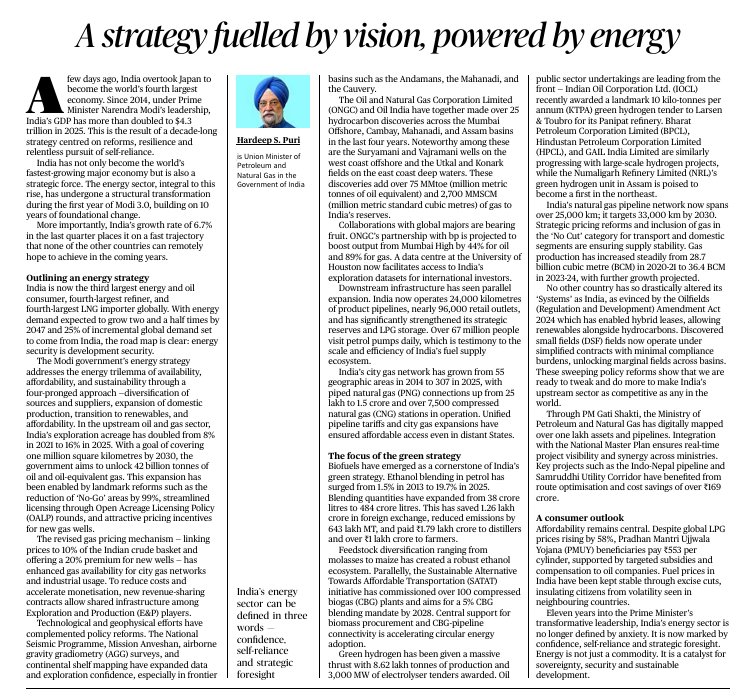. Central Theme
- India’s energy transformation strategy post-2014.
- Structural shift towards energy security, self-reliance, and sustainability.
- Energy as a key driver of India’s economic growth and geopolitical confidence.
2. Strategic Vision Components
- Reforms, resilience, and self-reliance in energy governance.
- Focus on the energy trilemma:
a) Availability
b) Affordability
c) Sustainability
3. Achievements in Oil & Gas Sector
- India is now:
- 3rd largest energy consumer
- 4th largest refiner
- 2nd largest LPG consumer
- Among top 10 gas markets globally
- 3rd largest energy consumer
- Domestic oil & gas exploration increased from 6% (2021) to 16% (2025 target).
- Goal: Cover 1 million sq. km under exploration by 2030.
4. Policy Reforms & Enablers
- Open Acreage Licensing Policy (OALP) – simplified bidding process.
- Gas pricing reforms – linking prices to global benchmarks.
- Reduction in ‘No-Go’ exploration zones.
- Focus on compressed biogas (CBG), green hydrogen, and biofuels.
5. Infrastructure Expansion
- Natural gas pipeline network expanded from 21,000 km to over 23,500 km.
- City Gas Distribution (CGD) expanded from 55 districts (2014) to 630+.
- 7,500+ CNG stations operational.
- LNG import terminals and pipeline infrastructure built for last-mile delivery.
6. Green and Renewable Integration
- Focus on biofuels (ethanol, CBG, biodiesel).
- Ethanol blending rose from 1.5% (2013) to 12% (2023); target 20% by 2025.
- Reduced CO₂ emissions by 7 crore tonnes, saved ₹54,000 crore in import bills.
- Promoted sustainable aviation fuel, waste-to-energy, and flex-fuel vehicles.
7. International & Domestic Collaborations
- Collaborations with global oil majors (e.g., ExxonMobil, Shell) in exploration.
- Foreign Direct Investment in green energy corridors.
- Expansion into data centres and hydrogen corridors (e.g., IOC, BPCL, HPCL green hydrogen projects).
8. Digital & Technological Support
- Unified mapping under National Gas Grid and One Nation One Grid
- National Master Plan under PM Gati Shakti for real-time infra monitoring.
- Digital platforms integrated into pipeline safety, grid management, and refinery logistics.
- Governance & Administrative Reforms
- Multiple ministries streamlined for energy project clearances.
- Rationalisation of subsidies and tax incentives.
- Consumer-centric model ensuring equitable access and pricing efficiency.
- Keywords for Note-making
- Energy security
- Energy trilemma
- Atmanirbhar energy policy
- Biofuel economy
- Pipeline diplomacy
- Strategic petroleum reserves
- Open Acreage Licensing Policy (OALP)
- Compressed biogas (CBG)
- PM Gati Shakti – Energy mapping
- Circular economy in energy
- Green hydrogen mission
- Last-mile energy equity
- Data centre–energy synergy
- Global South energy cooperation
GS Paper III – Economy / Energy / Infrastructure
Q1. India’s energy sector is undergoing a structural transformation that balances availability, affordability, and sustainability. Discuss the key features of India’s current energy strategy and its implications for long-term economic growth.
(15 marks / 250 words)


